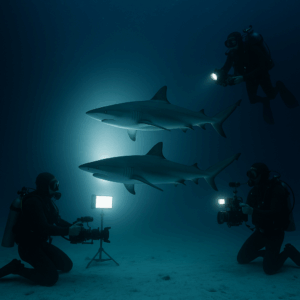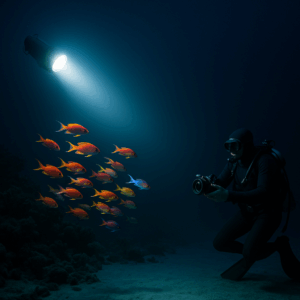A Director’s Guide to Using Adjustable RGB+White LEDs for Ocean and Pool Scenes
Creating visually stunning aquatic scenes—whether above the waves or beneath the surface—has long challenged filmmakers. The ocean’s vast expanse, the reflections and refractions of water, and the ever-shifting play of natural light create a dynamic canvas that’s both rewarding and demanding. Similarly, pool scenes, often contained but no less complex, require careful control of light to maintain believability and emotional tone.
Enter adjustable RGB+White LED lighting, a powerful, flexible solution that empowers directors to recreate naturalistic and stylized water scenes with precision. These advanced lighting tools are transforming how aquatic cinematography is approached, offering unmatched versatility for mood, realism, and creative expression.
Before diving into how RGB+White LEDs enhance aquatic scenes, it’s crucial to understand what sets them apart.
RGB vs. RGB+White
Traditional RGB LEDs combine red, green, and blue to produce a wide color gamut. However, they often fall short in accurately reproducing true white light or subtle natural tones. This is where RGB+White (RGBW) LEDs shine. By adding a dedicated white diode—often adjustable between tungsten (3200K) and daylight (5600K)—filmmakers gain precise control over both color and color temperature.
Benefits of RGB+White LEDs
Water isn’t just another surface—it absorbs and refracts light in unique ways. Understanding how light interacts with water is fundamental.
Refraction and Absorption
Light entering water bends and loses intensity. Red wavelengths fade first, while blue and green penetrate deeper, influencing how color appears underwater. Directors must account for this when choosing lighting hues.
Reflection and Glare
Surface water reflects light like a mirror, creating hotspots or distracting highlights if not carefully controlled. Using adjustable RGBW lighting lets you modulate intensity and angle precisely.
Scene-Specific Needs
The right lighting choices support the mood, time of day, and narrative function of the scene.
Preparation is everything. Here’s how to integrate RGB+White LED lighting into your aquatic shoot from the start.
Scout with Lighting in Mind
Whether shooting on an open coastline, an indoor pool, or a water tank, evaluate:
Plan Your Rigging and Safety
Water and electronics don’t mix—unless you plan wisely:
Test the Setup
Dry runs are critical. Conduct pre-light tests with actual lenses and camera settings to:

RGB+White LEDs are not just practical—they’re powerful storytelling tools.
Cool Daylight Blues
To mimic natural ocean lighting during the day:
Romantic Ambers and Magentas
For poolside evening scenes or intimate moments:
Moody Night Scenes
Ocean scenes at night are tough—but RGBW makes them manageable:
Fantasy and Sci-Fi Worlds
Unnatural colors can feel completely natural—when motivated:
Theory meets practice in the way you position and manipulate light.
Above-Water Lighting
Overhead lights set the tone for reflections and shadows:
Underwater Lighting
For underwater scenes, waterproof fixtures must:
RGB+White underwater lights can replicate:
Rippling and Water Effects
Use RGB+White sources with physical movement:

Even the best lighting won’t work without harmony with your camera system.
Color Matching and White Balance
Modern cinema cameras often have custom white balance tools. When using RGB+White LEDs:
Dealing with Reflections and Glare
Use polarizing filters to manage surface reflections
Frame Rate and Flicker
Some LED fixtures can flicker at high shutter speeds. Use:
Water is unforgiving. Every LED fixture used must pass safety checks.
Waterproofing and Ratings
Understand Ingress Protection (IP) standards:
Use sealed power connectors, gel packs, and dry bags to protect controls and batteries.
Heat and Condensation
LEDs produce heat. In wet environments:
Battery and Cable Management
Let’s examine how RGB+White LEDs elevate real-world aquatic scenes.
Scene Study: Thriller at Sea
A low-budget production filmed an intense rescue scene using only:
Result? A visually rich scene that felt like it was shot miles offshore.
Scene Study: Poolside Romance
An indie drama’s nighttime pool sequence used:
Directors cited the emotional clarity enabled by precise, real-time color adjustment.

Director Testimonial
“We had no time to relight between takes. The ability to shift from sunset amber to moonlit blue with a single control was a game-changer.”
— Sophia Anders, director of Saltwater Dreams
Even perfect lighting may need tweaks in post—but RGB+White LEDs give editors more to work with.
Color Correction Advantages
Using tunable RGB+White light in production:
VFX Integration
RGBW lighting captures metadata from smart fixtures (DMX, CRMX, or app control). This:
Scene Continuity
Aquatic scenes are often shot out of sequence. RGB+White lighting:
The challenges of aquatic cinematography are undeniable—but with adjustable RGB+White LED lighting, directors are no longer constrained by nature or limited by traditional lighting rigs. These tools empower filmmakers to:
Whether you’re shooting a deep-sea thriller, a romantic pool interlude, or an otherworldly underwater realm, RGB+White LEDs provide the precision, flexibility, and creativity today’s visual storytelling demands.
–The End–
Get in touch for free lighting customization